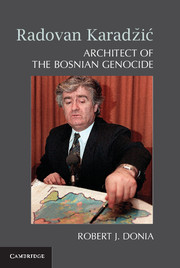Book contents
- Frontmatter
- Dedication
- Contents
- List of Maps, Tables, and Illustrations
- Preface
- Acknowledgments
- Introduction
- 1 Youth of Hardship, Lands of Lore
- 2 Sacrificial Founder
- 3 Naïve Nationalist
- 4 Milošević’s Willing Disciple
- 5 The Autumn of Radovan’s Rage
- 6 Visionary Planner
- 7 Euroskeptic
- 8 Imperious Serb Unifier
- 9 Triumphant Conspirator
- 10 Strategic Multitasker
- 11 Callous Perpetrator
- 12 Duplicitous Diplomat
- 13 Host in Solitude
- 14 Architect of Genocide
- 15 Falling Star
- 16 Resourceful Fugitive
- Conclusion: Radovan Karadžić and the Bosnian War
- Chronology of Events
- List of Acronyms and Terms
- Bibliography
- Index
- References
Bibliography
Published online by Cambridge University Press: 05 October 2014
- Frontmatter
- Dedication
- Contents
- List of Maps, Tables, and Illustrations
- Preface
- Acknowledgments
- Introduction
- 1 Youth of Hardship, Lands of Lore
- 2 Sacrificial Founder
- 3 Naïve Nationalist
- 4 Milošević’s Willing Disciple
- 5 The Autumn of Radovan’s Rage
- 6 Visionary Planner
- 7 Euroskeptic
- 8 Imperious Serb Unifier
- 9 Triumphant Conspirator
- 10 Strategic Multitasker
- 11 Callous Perpetrator
- 12 Duplicitous Diplomat
- 13 Host in Solitude
- 14 Architect of Genocide
- 15 Falling Star
- 16 Resourceful Fugitive
- Conclusion: Radovan Karadžić and the Bosnian War
- Chronology of Events
- List of Acronyms and Terms
- Bibliography
- Index
- References
Summary

- Type
- Chapter
- Information
- Radovan KaradžičArchitect of the Bosnian Genocide, pp. 323 - 330Publisher: Cambridge University PressPrint publication year: 2014



